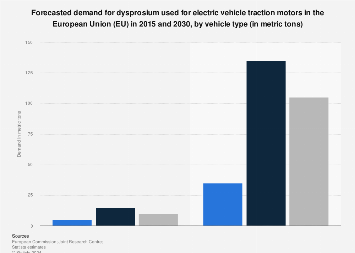The Electric Vehicle Revolution And The Looming Dysprosium Shortage

Table of Contents
Dysprosium's Crucial Role in Electric Vehicle Motors
Electric vehicle motors rely heavily on powerful neodymium magnets to convert electrical energy into mechanical motion. These magnets are not simply strong; they need to maintain their strength across a wide range of temperatures and operating conditions. This is where dysprosium becomes indispensable. Dysprosium is a crucial additive in neodymium magnets, significantly enhancing their magnetic properties, specifically their resistance to demagnetization at high temperatures. This is vital for the optimal performance and longevity of EV motors. Dysprosium-enhanced magnets provide:
- Higher temperature resistance: Ensuring consistent performance even under demanding conditions.
- Stronger magnetic field: Leading to greater motor efficiency and power output.
Dysprosium magnets are integral components in various EV systems, including:
- Traction motors: The primary motors responsible for propelling the vehicle.
- On-board chargers: Converting AC power from the grid to DC power for the battery.
- Power steering systems: Assisting the driver in steering the vehicle.
The Current State of Dysprosium Supply and Demand
The production of dysprosium is geographically concentrated, with China currently dominating the global supply chain. This dependence on a single major supplier creates significant geopolitical risks and vulnerabilities. The rapidly expanding EV market is driving an unprecedented surge in demand for dysprosium, far outpacing current production rates.
Current dysprosium reserves and production rates are insufficient to meet the projected needs of the growing EV industry. This imbalance is further exacerbated by:
- Limited mining and processing capacity: The extraction and processing of dysprosium are complex and environmentally challenging processes, limiting the rate of production.
- Geopolitical risks associated with reliance on a single major supplier: This creates vulnerability to supply disruptions due to political instability, trade disputes, or other unforeseen circumstances.
- Environmental concerns related to dysprosium mining: Dysprosium mining can have significant environmental impacts, requiring responsible and sustainable practices.
The Impact of a Dysprosium Shortage on the EV Industry
A severe dysprosium shortage would have profound consequences for the EV industry and the broader transition to sustainable transportation. The potential impacts include:
- Increased EV production costs: The scarcity of dysprosium will inevitably drive up its price, increasing the manufacturing costs of EVs.
- Delays in EV production and roll-out: Insufficient dysprosium supply could lead to production bottlenecks and delays in bringing new EV models to market.
- Potential price hikes for electric vehicles: Higher production costs will likely translate into higher prices for consumers, potentially hindering EV adoption.
- Supply chain disruptions impacting the entire automotive sector: The shortage could ripple through the entire automotive supply chain, causing widespread disruptions.
The scarcity of dysprosium could create significant market volatility and price fluctuations, making long-term planning and investment in the EV sector challenging. This uncertainty directly impacts the broader goal of transitioning to a cleaner, more sustainable transportation system.
Potential Solutions and Mitigation Strategies
Addressing the looming dysprosium shortage requires a multi-faceted approach involving technological innovation, policy changes, and international cooperation. Potential solutions include:
- Alternative magnet materials: Research into alternative magnet materials, such as ferrite magnets or less dysprosium-dependent neodymium magnets, is crucial to reduce reliance on this critical rare earth element.
- Dysprosium recycling and urban mining: Recycling discarded electronics and recovering dysprosium from end-of-life products can significantly supplement primary production. Urban mining, focusing on extracting valuable materials from existing waste streams, holds immense potential.
- Investing in research and development: Increased investment in research and development is essential to find more sustainable and efficient methods of dysprosium extraction, processing, and refinement.
Strategies for mitigating the dysprosium shortage include:
- Government policies promoting responsible mining and recycling: Incentivizing sustainable mining practices and investing in robust recycling infrastructure.
- International collaborations to secure dysprosium supplies: Establishing international partnerships to ensure stable and diversified supply chains.
- Investment in research and development of alternative magnet technologies: Funding research into innovative magnet designs that minimize or eliminate the need for dysprosium.
Conclusion: Addressing the Dysprosium Shortage for a Sustainable EV Future
The looming dysprosium shortage presents a significant challenge to the electric vehicle revolution. Dysprosium's critical role in high-performance EV motors underscores the urgency of addressing the supply chain vulnerabilities and exploring alternative solutions. By investing in research and development, promoting responsible mining and recycling practices, and fostering international cooperation, we can mitigate the risks of a dysprosium shortage and ensure the continued success of the EV industry. We must actively participate in finding solutions to the dysprosium shortage to secure a sustainable transportation future. Further research into the dysprosium shortage, rare earth elements, and electric vehicle battery technology is crucial for navigating this critical challenge.

Featured Posts
-
 Analysis Ecb Links Post Pandemic Fiscal Measures To Persistent Inflation
Apr 29, 2025
Analysis Ecb Links Post Pandemic Fiscal Measures To Persistent Inflation
Apr 29, 2025 -
 Convicted Cardinal Challenges Conclave Voting Eligibility Rules
Apr 29, 2025
Convicted Cardinal Challenges Conclave Voting Eligibility Rules
Apr 29, 2025 -
 Hengrui Pharma Secures China Regulator Approval For Hong Kong Ipo
Apr 29, 2025
Hengrui Pharma Secures China Regulator Approval For Hong Kong Ipo
Apr 29, 2025 -
 Capital Summertime Ball 2025 Tickets Purchase Process And Important Dates
Apr 29, 2025
Capital Summertime Ball 2025 Tickets Purchase Process And Important Dates
Apr 29, 2025 -
 Severe Weather Pummels Louisville Snow Tornadoes And Historic Flooding In 2025
Apr 29, 2025
Severe Weather Pummels Louisville Snow Tornadoes And Historic Flooding In 2025
Apr 29, 2025
